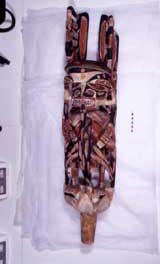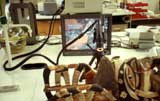| |
|
 |
 |
 |
 |
Joao Penalva -'The Eternal Artefact?'
British Museum, Conservation Research Laboratory, March 2000-1.
This Sci-Art funded research project involved a form of 'residency' at the British Museum with artist Joåo
Penalva who entered into a dialogue with Conservation Research Scientist, Susan Bradley and Principal Conservator,
Gillian Roy. His research involved studying the Museum's approach to the preservation of organic artefacts. He
focussed on a specific object from the Museum's ethnographic reserve, a carved wooden Malangan figure from Papua,
New Guinea.
This type of figure would have been used for a ritual celebration by a particular clan to honour its dead. Every Malangan
figure is unique to each family with all the iconographical details related to the carver without any visual reference.
Thus its shaping is directed by the 'owner' of the carving pattern and communicated verbally, from memory, to the carver.
Penalva was fascinated by the idea that such a complex carving can have continued to be created in a recognisable form,
carried on from generation to generation despite its ephemerality since after the ceremony, the clan would burn or discard
it. In contrast the Museum has a mission to preserve it as a tangible artefact for posterity to provide a source for
future research into disappearing or lost cultures. The role of conservators and scientists is to slow down the processes
of deterioration. With their careful and painstaking work they strive to prevent and rectify damage caused by heat, damp,
sunlight, pests and human negligence. The conservation scientists, led by Susan Bradley, conducted specific tests on the
artefact, to learn more about its construction and history. Penalva could thus study and evaluate their scientific
analysis reports, conservation and inventory records relating to the carving which generated many images - graphs,
microscope and ultra-violet views and x-rays in addition to the extensive documentation relating to the provenance of the
artefact. His project focussed on monitoring and documenting the artefact's 'journey to the Museum and subsequently through
the conservation laboratory:
...'I gained some familiarity with the collection, the objects that interested me most were those that fell into this
category of objects that 'should not' be in a Museum Collection; that is, those whose social, ritual, or religious function
they were produced to perform encompassed also their ritualistic destruction. These 'saved' objects are in fact the
embodiment of a museological practice whose ethics - past and present, in this country and abroad - I found interesting to
investigate. One object, a Malangan carving had so much documented history behind it that it alone became the sole focus
of this project.
A full investigation was carried out on this carving, and from the life and collecting interests and original Western
proprietor in New Ireland - the amateur anthropologist/photographer and collector, the Rev. George Brown - to its subsequent
travel to England, its negated export sale to Japan, its separation from the rest of the Reverend's collection, to its
arrival at The British Museum, there is an endless stream of stories involving people, their institutions, attitudes and
prejudices that are worth pursuing. In fact the more I investigate the more the carving's history branches out into new
areas of culture.'
...From the beginning of the project my main interest has lied in the process of elaborating a definition of the Malangan
carving as artefact and museum item in the various 'languages' spoken in the different areas of research it has passed through.'
|
|
 |
 |
Malangan Figure - BM Ethnography Collection 1986 OC
3.
|
 |
 |
British Museum conservation scientists examing Malangan figure.
|
 |
 |
British Museum conservation scientists examing Malangan
figure.
|

|
 |
 |
|
|
|